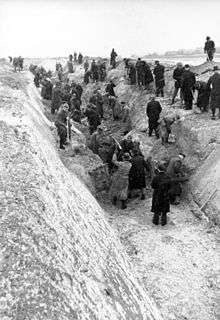Anti-tank trench

Men of the Volkssturm-militia digging an anti-tank ditch during the Battle of Berlin at the outskirts of the city (February 1945)
Anti-tank trenches, also called anti-tank ditches, are ditches dug into and around fortified positions to hold up the advance of enemy tanks.[1][2] Anti-tank ditches were first used in World War I by Germany in an effort to protect their trenches against the newly developed British tanks. An anti-tank ditch has to be wide enough and deep enough to prevent a tank from crossing. Armies have been known to disguise anti-tank ditches[3] to enable the ditch to disable an enemy tank.
See also
| Wikimedia Commons has media related to Anti-tank trenches. |
References
- ↑ "12. Antitank Obstacles and Road Blocks: Beach Obstacles: German Coastal Defenses, WWII Military Intelligence Service, Special Series No. 15, June 15, 1943 (Lone Sentry)". www.lonesentry.com. Retrieved 2017-12-18.
- ↑ Rottman, Gordon L. (2012-12-20). Soviet Field Fortifications 1941–45. Bloomsbury Publishing. ISBN 978-1-84908-061-3.
- ↑ The Military Engineer. Society of American Military Engineers. 1919.
This article is issued from
Wikipedia.
The text is licensed under Creative Commons - Attribution - Sharealike.
Additional terms may apply for the media files.